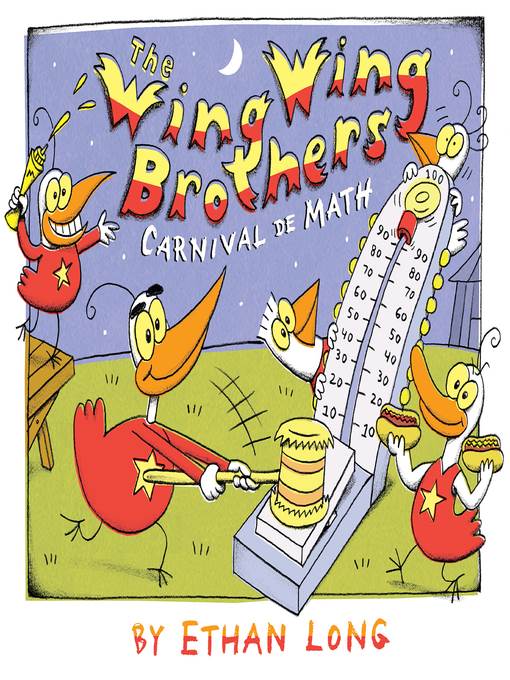
The Wing Wing Brothers Carnival de Math
فرمت کتاب
ebook
تاریخ انتشار
2013
Reading Level
0-1
ATOS
2.2
Interest Level
K-3(LG)
نویسنده
Ethan Longناشر
Holiday Houseشابک
9780823428069
کتاب های مرتبط
- اطلاعات
- نقد و بررسی
- دیدگاه کاربران
نقد و بررسی

February 25, 2013
The eponymous fowl siblings, first seen in The Wing Wing Brothers Math Spectacular!, test their computing strengths in carnival activities that address counting, adding, and subtracting by 10s. In the first episode, Willy, Wendell, Woody, Wilmer, and Walter take whacks at a high striker (“Willy tests his strength. But he is a weakling. He scores 10”); a hot dog–eating contest and ride on the Wedgie Wheel offer counting addition/subtraction opportunities (“Can Willy eat the last 10 wieners? Yes! 10 – 10 = 0. Willy is the wiener winner!”). Long makes each concept clear in his comics-style panels, but he keeps the emphasis on fun throughout (each of the three story segments ends with a gag of some kind), augmenting these math lessons with plenty of laughs. Ages 4–8.

April 1, 2013
The first, fabulous vaudevillian math escapades of the Wing Wing Brothers (The Wing Wing Brothers Math Spectacular, 2012) give way to this lackluster second adventure at a carnival, with the action divided into three amusements. Focusing on counting to 100 by 10s, the first amusement finds the five brothers competing to ring the bell at the top of a strength tower. While each brother does better than the last, the fifth one providing the slapstick they are known for, and each scores a multiple of 10, there is no counting here. The second amusement at least involves math: Each brother has a tray of 10, 20 or 30 wieners, which readers count as they come to the table, then subtract as the brothers gorge themselves sick. The last episode puts the brothers on the Wedgie Wheel. Readers add and subtract by 10s and 20s as the ride stops at each car, loading and unloading passengers. Prominent mathematical equations in a large red typeface help readers with the math in the last two amusements, though since the answers are included, they don't really have to think at all. Long's pencil-and-digital illustrations are still comical, but the slapstick just isn't as funny this time around. Ultimately, this lacks the solid and seamless math practice of the first; it's just some math annoyingly mixed with a few kinda-funny jokes. (Math picture book. 4-8)
COPYRIGHT(2013) Kirkus Reviews, ALL RIGHTS RESERVED.

April 1, 2013
K-Gr 1-The Wing Wing brothers are five ducks whose adventures are intended to teach mathematical concepts. In three separate stories, they attend a Carnival De Math. In "Amusement 1," they try their hand at a strength contest; in the second, they purchase and then eat trays of hot dogs; and in the last, they ride the Wedgie (Ferris) Wheel. In each vignette, the Common Core math concept is stated at the beginning ("Counting to 100 by Tens," "Addition and Subtraction by 10 up to 100," and "Adding within 100, including a 2-Digit Number and a 1-Digit Number"). For Amusements 2 and 3, each step of the math is spelled out, while in Amusement 1, readers must draw their own conclusions. Though the stories are slight, the target audience will most likely enjoy the silly humor and cartoon illustrations, created with black Prismacolor pencils and colored digitally. Alliterative text raises the wacky factor, but also leads to the misstep of calling hot dogs "wieners." Elementary school children will be amused by the statement, "Wendell has 10 wieners," but probably not in the way the author intends. For larger collections where math titles are in demand.-Rachael Stein, Eastern Shore Regional Library, Salisbury, MD
Copyright 2013 School Library Journal, LLC Used with permission.

























دیدگاه کاربران